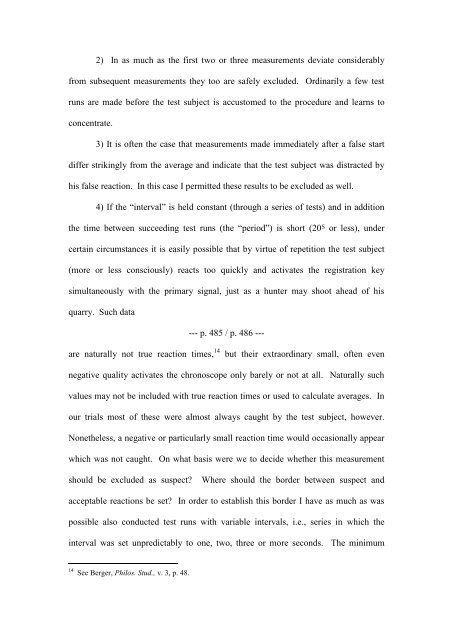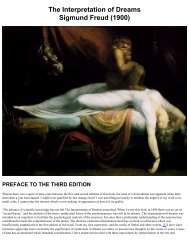Lange, L - Classics in the History of Psychology
Lange, L - Classics in the History of Psychology
Lange, L - Classics in the History of Psychology
Create successful ePaper yourself
Turn your PDF publications into a flip-book with our unique Google optimized e-Paper software.
2) In as much as <strong>the</strong> first two or three measurements deviate considerably<br />
from subsequent measurements <strong>the</strong>y too are safely excluded. Ord<strong>in</strong>arily a few test<br />
runs are made before <strong>the</strong> test subject is accustomed to <strong>the</strong> procedure and learns to<br />
concentrate.<br />
3) It is <strong>of</strong>ten <strong>the</strong> case that measurements made immediately after a false start<br />
differ strik<strong>in</strong>gly from <strong>the</strong> average and <strong>in</strong>dicate that <strong>the</strong> test subject was distracted by<br />
his false reaction. In this case I permitted <strong>the</strong>se results to be excluded as well.<br />
4) If <strong>the</strong> “<strong>in</strong>terval” is held constant (through a series <strong>of</strong> tests) and <strong>in</strong> addition<br />
<strong>the</strong> time between succeed<strong>in</strong>g test runs (<strong>the</strong> “period”) is short (20 S or less), under<br />
certa<strong>in</strong> circumstances it is easily possible that by virtue <strong>of</strong> repetition <strong>the</strong> test subject<br />
(more or less consciously) reacts too quickly and activates <strong>the</strong> registration key<br />
simultaneously with <strong>the</strong> primary signal, just as a hunter may shoot ahead <strong>of</strong> his<br />
quarry. Such data<br />
--- p. 485 / p. 486 ---<br />
are naturally not true reaction times, 14 but <strong>the</strong>ir extraord<strong>in</strong>ary small, <strong>of</strong>ten even<br />
negative quality activates <strong>the</strong> chronoscope only barely or not at all. Naturally such<br />
values may not be <strong>in</strong>cluded with true reaction times or used to calculate averages. In<br />
our trials most <strong>of</strong> <strong>the</strong>se were almost always caught by <strong>the</strong> test subject, however.<br />
None<strong>the</strong>less, a negative or particularly small reaction time would occasionally appear<br />
which was not caught. On what basis were we to decide whe<strong>the</strong>r this measurement<br />
should be excluded as suspect? Where should <strong>the</strong> border between suspect and<br />
acceptable reactions be set? In order to establish this border I have as much as was<br />
possible also conducted test runs with variable <strong>in</strong>tervals, i.e., series <strong>in</strong> which <strong>the</strong><br />
<strong>in</strong>terval was set unpredictably to one, two, three or more seconds. The m<strong>in</strong>imum<br />
14 See Berger, Philos. Stud., v. 3, p. 48.



